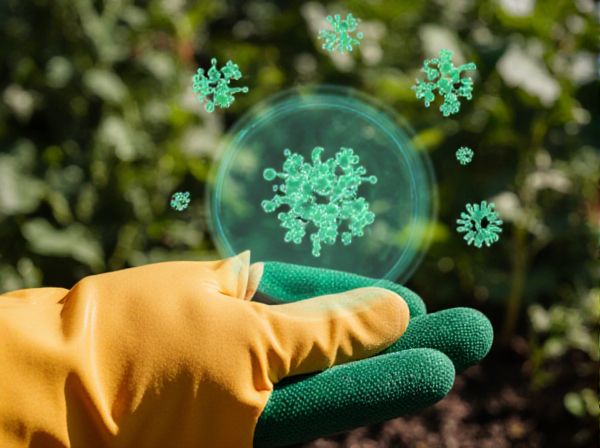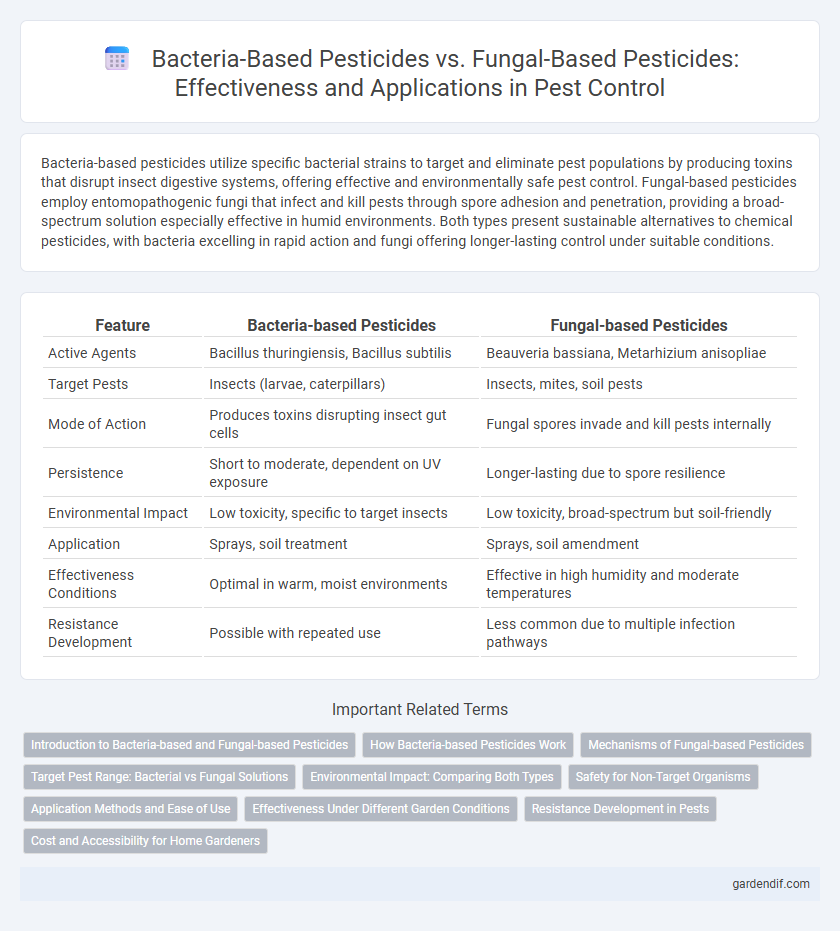
Bacteria-based Pesticides vs Fungal-based Pesticides Illustration
Bacteria-based pesticides utilize specific bacterial strains to target and eliminate pest populations by producing toxins that disrupt insect digestive systems, offering effective and environmentally safe pest control. Fungal-based pesticides employ entomopathogenic fungi that infect and kill pests through spore adhesion and penetration, providing a broad-spectrum solution especially effective in humid environments. Both types present sustainable alternatives to chemical pesticides, with bacteria excelling in rapid action and fungi offering longer-lasting control under suitable conditions.
Table of Comparison
| Feature | Bacteria-based Pesticides | Fungal-based Pesticides |
|---|---|---|
| Active Agents | Bacillus thuringiensis, Bacillus subtilis | Beauveria bassiana, Metarhizium anisopliae |
| Target Pests | Insects (larvae, caterpillars) | Insects, mites, soil pests |
| Mode of Action | Produces toxins disrupting insect gut cells | Fungal spores invade and kill pests internally |
| Persistence | Short to moderate, dependent on UV exposure | Longer-lasting due to spore resilience |
| Environmental Impact | Low toxicity, specific to target insects | Low toxicity, broad-spectrum but soil-friendly |
| Application | Sprays, soil treatment | Sprays, soil amendment |
| Effectiveness Conditions | Optimal in warm, moist environments | Effective in high humidity and moderate temperatures |
| Resistance Development | Possible with repeated use | Less common due to multiple infection pathways |
Introduction to Bacteria-based and Fungal-based Pesticides
Bacteria-based pesticides, such as Bacillus thuringiensis, utilize specific bacterial strains that produce toxins targeting insect pests without harming beneficial organisms or the environment. Fungal-based pesticides rely on entomopathogenic fungi like Beauveria bassiana, which infect and kill insect pests by penetrating their exoskeletons and disrupting physiological functions. Both types offer sustainable pest control alternatives by harnessing natural microbial agents to reduce chemical pesticide dependence.
How Bacteria-based Pesticides Work
Bacteria-based pesticides operate by introducing specific bacterial strains such as Bacillus thuringiensis (Bt) that produce toxic proteins targeting pest larvae's gut lining, disrupting digestion and causing death. These bioinsecticides act selectively on insect pests, minimizing harm to beneficial insects and the environment. Their mode of action includes spore germination within the pest, toxin release, and rapid infestation control in agricultural settings.
Mechanisms of Fungal-based Pesticides
Fungal-based pesticides operate by infecting target pests through spore adhesion, germination, and penetration of the host cuticle, leading to internal colonization and disruption of vital physiological processes. These entomopathogenic fungi produce enzymes such as chitinases and proteases that degrade the insect exoskeleton, enabling fungal hyphae to invade and proliferate within the pest's body. The biological mechanism also involves the secretion of secondary metabolites and toxins that suppress the insect's immune response, culminating in mortality and effective pest control.
Target Pest Range: Bacterial vs Fungal Solutions
Bacteria-based pesticides primarily target specific insect pests such as larvae of moths and beetles by producing toxins that disrupt their digestive systems, offering a narrow but effective pest range. Fungal-based pesticides exhibit a broader spectrum, infecting a wide variety of pests including insects, mites, and nematodes through direct penetration and colonization of the host. These natural microbial agents differ significantly in host specificity, with bacterial pesticides favoring select insect classes, while fungal pesticides can control multiple pest taxa across agricultural and horticultural ecosystems.
Environmental Impact: Comparing Both Types
Bacteria-based pesticides such as Bacillus thuringiensis offer targeted pest control with minimal non-target species disruption, promoting soil health and reducing chemical residues. Fungal-based pesticides like Beauveria bassiana contribute to ecosystem balance by naturally suppressing pest populations but may pose higher risks to beneficial insects under certain conditions. Both types present eco-friendly alternatives to chemical pesticides, yet their environmental impact varies based on application methods and pest specificity.
Safety for Non-Target Organisms
Bacteria-based pesticides, such as Bacillus thuringiensis, exhibit high specificity, targeting pest insects while posing minimal risk to non-target organisms including beneficial insects, wildlife, and humans. Fungal-based pesticides like Beauveria bassiana can have broader host ranges, occasionally affecting non-target arthropods but generally maintaining safety profiles under controlled application conditions. Both microbial pesticide types reduce chemical pesticide hazards, making them environmentally safer options in integrated pest management programs.
Application Methods and Ease of Use
Bacteria-based pesticides are commonly applied as sprays or soil amendments, offering versatility for targeting specific pests and diseases, with ease of use supported by compatibility with standard spraying equipment. Fungal-based pesticides usually require precise environmental conditions and careful handling during application, often delivered through sprays, granules, or seed coatings, which can complicate their usage in large-scale or varied field conditions. Both types demand adherence to specific protocols to maintain microbial viability, but bacteria-based formulations generally provide more straightforward application methods suitable for diverse agricultural settings.
Effectiveness Under Different Garden Conditions
Bacteria-based pesticides, such as Bacillus thuringiensis, are highly effective against specific insect pests in well-drained, warm garden soils where rapid microbial activity enhances their potency. Fungal-based pesticides, including Beauveria bassiana, perform better in moist, shaded environments as high humidity levels support fungal spore germination and infection rates. Understanding soil moisture, temperature, and sunlight exposure allows gardeners to select the optimal microbial pesticide, improving pest control success across diverse garden conditions.
Resistance Development in Pests
Bacteria-based pesticides, such as Bacillus thuringiensis, pose a higher risk of resistance development due to the single-mode action targeting specific pest receptors. Fungal-based pesticides, including Beauveria bassiana and Metarhizium anisopliae, exhibit multiple infection mechanisms that reduce pest resistance buildup. Integrated pest management strategies leverage the complementary modes of action of bacteria and fungi to delay resistance and enhance long-term efficacy.
Cost and Accessibility for Home Gardeners
Bacteria-based pesticides, such as those containing Bacillus thuringiensis, tend to be more affordable and widely available in retail stores, making them accessible options for home gardeners. Fungal-based pesticides, including formulations with Beauveria bassiana, often come at a higher price point and may require special ordering or sourcing from specialty suppliers. The cost-effectiveness and ease of procurement make bacteria-based products a preferred choice for budget-conscious and convenience-focused garden enthusiasts.
Bacteria-based Pesticides vs Fungal-based Pesticides Infographic

 gardendif.com
gardendif.com